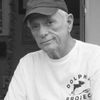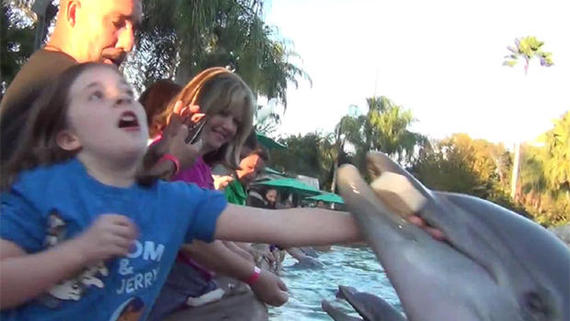It's all about the turnstile
~ by Ric O'Barry, Founder/Director of Dolphin Project
SeaWorld and their new partner, The Humane Society of the United States* (HSUS), recently announced the end of SeaWorld's captive breeding (actually inbreeding) program for orcas. We welcome that. It's good news.
* Not to be confused with your local humane society.
But there's some bad news, too: all other species of dolphin are excluded from the breeding ban.
Captive breeding for the vast majority of dolphins in the various SeaWorld amusement parks will not be phased out. They say, "it could happen," but I'm not buying pie in the sky or the old carrot and stick trick. Let's stick with what we know and what is real: sperm on demand and artificial insemination will continue for the majority of SeaWorld's dolphins, now, with the blessing of HSUS.
SeaWorld also announced a change in the orca shows. No more "theatrical orca shows" in favor of "orca exhibits" that "highlight the whales' natural behaviors." That part of the deal is just corporate spin.
Rendering of SeaWorld's new orca encounter
Photo: SeaWorld
Most of the surviving orcas at SeaWorld were born in an unnatural, artificial, concrete, glass and steel environment. These particular orcas are, in some way, freaks that SeaWorld created for our amusement - and for their own corporate profit. They do not represent orcas in nature by any stretch of the imagination. The only way that captive-born dolphins (including orcas, which are the largest species of dolphin) could serve to educate the public to something of value is if they are identified for what they really are: victims. SeaWorld would actually have to tell their audiences the truth: keeping orcas and other dolphins in captivity is wrong. Including stillbirths, 20 orcas and 133 dolphins have died at SeaWorld in the last 24 years. These mammals are not ambassadors. They never were, and never could be.
Captivity was a bad idea from the very beginning. It all started at Marine Studios in St. Augustine, Florida in 1938. The dolphin captivity industry should have admitted decades ago that it was a failed experiment, a miserable and misguided undertaking.
I wonder if the new orca exhibit, endorsed by HSUS, will include the tragic history of SeaWorld's orcas? Will SeaWorld and HSUS tell the public where their first orcas came from? Will the new redesigned orca exhibit serve to educate the public to the many reasons why captivity is wrong?
Good education is based on truth, not corporate spin backed by a touch of greenwashing.
I intend to be there on the opening day of this rollout, and record what "SeaWorld Cares" calls their "...new, inspiring, natural orca encounters." Perhaps I'll live stream so that you can bear witness to this, too. No point in us all buying a ticket.
And herein lies the big problem: Now that SeaWorld has the blessing of HSUS, the public will assume it's okay to buy a ticket to SeaWorld. After all, HSUS is the largest animal welfare group in the world, boasting over 11 million supporters. This massive membership now has the green light to buy a ticket and file through SeaWorld's turnstiles, and they probably won't go alone, likely opting to bring along friends and family members. Now we're talking a potential hundred million new customers for the park. Assuming they each drop about $100.00 for a ticket, food and souvenirs, well, you can imagine what kind of serious money SeaWorld stands to rake in.
It gets better (for SeaWorld, not for the dolphins). These 11 million HSUS members are now free to buy stock in SeaWorld without having to feel guilty or being politically incorrect. Partners are partners, right? And those same friends and family members will likely want in on the action, too. I predict a huge windfall for those who bought stock in SeaWorld, especially the HSUS/SeaWorld insiders who knew about this partnership three months before they announced the new deal. (SeaWorld's stock has been climbing since their initial announcement on March 17.)
The big losers are the orcas, and all of the other dolphins at SeaWorld, including Busch Gardens, Discovery Cove and the various amusement parks owned by the multi-billion dollar corporation. Truth is, the new deal is actually going to be the same old song and dance, with a different set of words.
SeaWorld's announcement included a 50 million dollar budget to "save the whales," along with other critters. In a webcast on March 30, the corporation stated an intention to position itself as the number one rescue organization in the world, and establish global rescue centers, whether they build or partner with other organizations. With fifty million bucks, why not start by saving the whales in their own tanks, and create an orca sanctuary? Actually, they could create a sanctuary without the fifty million. SeaWorld has billions in the bank. Their partner, HSUS, has millions in their savings account. They raked almost 20 million last year. These are two very rich corporations.
Camp Lumba Lumba dolphin rehabilitation and release center, Indonesia
Credit: Dolphin Project
Desperation makes for strange bedfellows.
Joel Manby, the new CEO of SeaWorld, is a very clever businessman. The former car salesman is trying to sell us a lemon. He most likely thought that by partnering with HSUS, all of the activists would stop protesting. Boy, did he get that wrong. The real activists are abolitionists. They will not compromise. I'm one of them. Dolphin Project will continue our campaign to educate the public in the hope that each and every person will take the pledge to not buy a ticket to a dolphin show - any dolphin show.
The main point I want to stress is, please don't be fooled by slick, marketing videos featuring Joel Manby and President/CEO of HSUS, Wayne Pacelle. They will try to convince the public that dolphins cannot be retired in a coastal sanctuary environment. I'm not talking about a so-called seapen or floating cage but rather, a large bay, lagoon or cove. There are hundreds of them available on government land, and in fact, we the people own them. We may be able to use them free of charge. It's a matter of fencing off the mouth of a cove, for example, then building a medical pen, fish preparation house and all the usual infrastructure. Ideally, we should establish several of these in strategic locations around the world where dolphins are languishing in concrete tanks.
Manby and Pacelle say it's dangerous for the orcas to be moved from behind their turnstiles, but they provide no peer-reviewed scientific documentation to substantiate their claim.
The reason? Because this is a partnership of marketing, not dolphin welfare.
Ric O'Barry and Hugo, Miami Seaquarium
Photo: Dolphin Project Archives
I have been involved in the dolphin captivity issue for more than 56 years. I spent the first ten helping to build up the dolphin captivity industry, and the last 46 trying to tear it down. This body of work has consumed most of my life, and unlike Manby and Pacelle, I know from years of personal experience what I am talking about. I captured and trained more than a hundred dolphins, including the dolphins collectively known as the television star, "Flipper." I trained Hugo, the first orca held in captivity east of the Mississippi River. I also worked with manatees, seals, sea lions and otters.
Coastal dolphin sanctuaries will not be as slick or as profitable as SeaWorld's Shamu Stadium, but they have the potential to make money. P.T. Barnum, founder of Barnum & Bailey Circus said it best, "Build it and they will come."
Dolphin sanctuaries are for all dolphins. Size doesn't matter, and we don't play favorites. All dolphins are deserving of a proper retirement. On that note, as SeaWorld has indeed acknowledged that orca shows are no longer in public favor, then why punish their remaining animals by forcing them to live out the rest of their lives in concrete tanks? Why isn't their allegiance to the animals which have made them billions in profit?
The SeaWorld / HSUS Paradox
And this, folks, is what I call the SeaWorld/HSUS paradox. Manby and Pacelle want the public to buy stock, buy a ticket and return to SeaWorld's stadiums. In fact, their San Antonio park is set to unveil Discovery Point™ in May, 2016, which will feature a swim-with-the-dolphins program. Manby has also recently announced progress in SeaWorld's global expansion plans, saying the company had "moved to the next phase of our international development strategy."*
*Source: Attractions Management
It's all about money, members and goals of the highest abstraction.
The bottom line is; the surviving orcas should not remain locked up in concrete tanks. It's easy to do the right thing. Build a sanctuary. Then move your turnstiles there. Profits can still be made by embracing this new and progressive business model, and the dolphins can retire in peace and dignity.
So is it okay to go back to SeaWorld again? I say, no. Not until an exit strategy for all dolphins is committed to by both parties. In the absence of this, it's just business as usual - and a cruel one at that.




